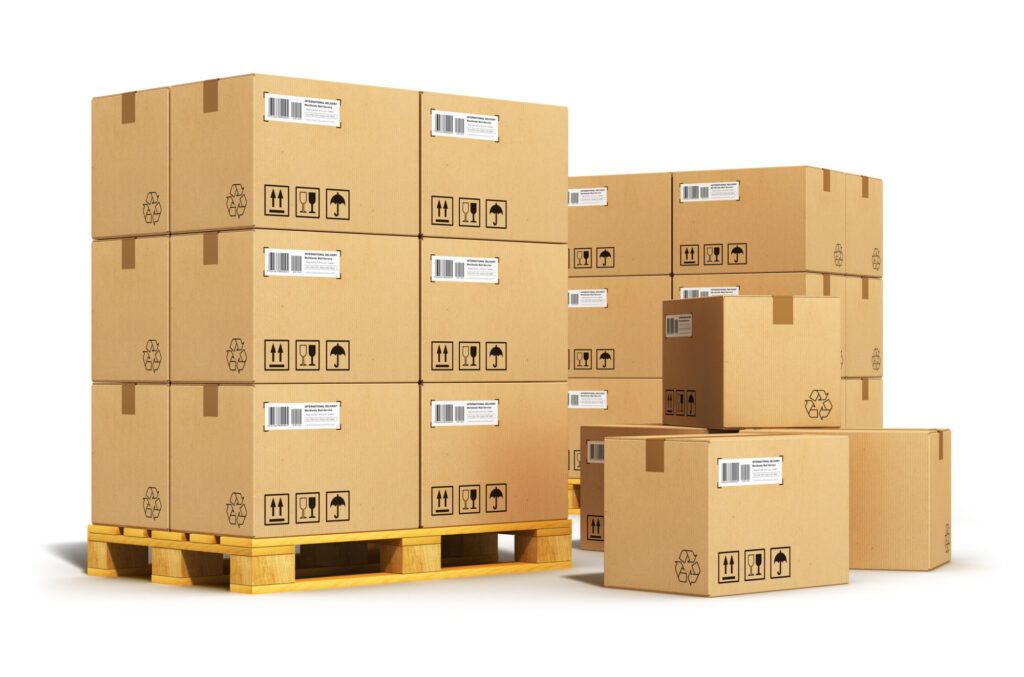Finding an affordable shipping option doesn’t mean you have to compromise on quality. Anyone can access competitive shipping rates with a bit of know-how—and since you’re here, you’re already on your way to more cost-effective shipping solutions. As we head into 2024, the landscape of e-commerce delivery is evolving. Today’s online shoppers expect their purchases to arrive quickly and without hefty shipping fees; some even look for free shipping. High delivery costs can deter potential customers and significantly impact your business.
It’s crucial to pinpoint the most economical shipping methods for reaching your customers, whether in different U.S. shipping zones or international locations. Mastering this aspect of your business will attract price-sensitive customers and keep you competitive and financially healthy.
So, what’s the cheapest way to ship a package currently? No universal solution fits every size and shape of a box. This article will help you understand the various factors that influence shipping rates and explore strategies to secure shipping discounts from major carriers.
Finding the Cheapest Shipping Rates in 2024
While lower shipping costs may seem elusive, affordable rates are within reach for any business that is willing to invest time and energy in finding them. The solutions are there; one must know where and how to look.
Various tools are available to simplify evaluating options and implement a smarter shipping strategy. Free shipping estimators and calculators, along with streamlined label creation and automated workflows, have a considerable potential to reduce spending and increase delivery speed.
To save money on shipping, create a thorough plan that fits your specific needs. This includes assessing all available carriers and services, examining your shipping quantities and destinations, consolidating shipments when possible, bargaining for reduced rates, and optimizing your profile settings.
Leveraging Multiple Carrier Accounts for Optimal Shipping Solutions
When we think about delivering goods, we often choose the same delivery methods and companies we’re familiar with, even if it means spending more money. But, it’s important to know that there are numerous affordable and quicker delivery options available apart from these usual ones.
To locate these options, you should assess reputable carriers such as USPS, UPS, DHL Express, and FedEx based on your specific shipping requirements. Each of these carriers has its own strengths for particular types of shipments. Therefore, comparing rates and services across various providers can assist you in finding the best fit for your shipping needs while keeping costs minimal.
To simplify this process, you can leverage shipping software and services with carrier access, rate shopping, label generation, and automatic application of the most budget-friendly rates for future shipments. Bundling multiple shippers into one can result in significant savings, up to 84% in some cases. So if you’re looking to optimize your shipping while saving money, it’s time to look beyond the familiar options and explore the unexplored. Remember, knowledge is power, so keep an eye out for those unrealized discounts.
How Can Businesses of Any Size Secure Affordable Shipping Rates?

Businesses of any size or scale can access affordable shipping rates, but smaller or newer companies often struggle to optimize their programs and secure competitive prices. However, with dedicated research, relationship building, and process refinement, even large enterprises can attain the desired discounts and cost savings. So, with commitment and effort, any business can achieve affordable and competitive shipping rates.
Your connections with top shipping providers and access to exclusive pricing tiers give you the chance to enjoy substantial reductions in rates with little or no impact on quality of service. You can save big on all kinds of shipping options, such as up to 84% on USPS Priority Mail, 78% on UPS ground shipping, 82% on international UPS shipments, and many more while maintaining or even improving speed and reliability.
While discounts are dynamic and volume-based, the strategies to secure them remain consistent. These include things like routinely comparing rates across providers, optimizing profile settings for your actual needs, bundling shipments when possible, negotiating volume contracts, leveraging all available tools for analysis and automation, and actively engaging providers and partners to discuss specialized offers.
How Can Businesses Balance Cost and Reliability?
A range of shipping services, from standard economy shipping to expedited express delivery, aims to provide goods to customers within designated timeframes while balancing cost and reliability. Offering affordable yet compelling options that meet key expectations around speed, convenience, and value is critical for merchants.
Various factors like the urgency of delivery, item-specific shipping, the destination where the product needs to be shipped, the profile of the sender, seasonal demands, and carrier capabilities affect the selection of the preferred and possibly discounted service for any given shipment. Some shippers specialize in rapid delivery, and others may excel at low-cost shipping, so evaluating each based on your profiles reveals the ideal at minimum spend.
Slower standard shipping continues to provide an inexpensive solution for non-urgent goods, especially for short-haul or domestic shipments. Services may aim for 3 to 7 or more business days in transit. Mid-range options like 2nd Day Air target delivery within 2 to 5 days at a moderate rate increase can balance costs and result in shipping.
Cheapest Shipping Rates Based on Delivery Speed

Based solely on the speed, here are the most popular three types of options:
1. Standard Shipping
Standard shipping options and costs vary substantially based on weight, dimensions, destination, contents, and timing needs. Lighter shipments under 16 ounces will typically utilize USPS First Class Mail, delivering affordably but within 3 to 5 business days.
Heavier goods require alternative ground shipping services with different transit times and rates. USPS Parcel Select Ground aims for delivery within 2 to 8 days at a lower cost but may not meet speed needs. USPS Media Mail prioritizes affordability over speed, taking 7 to 10 days on average for approved materials.
Carrier ground services like UPS Ground, USPS Priority Mail, and FedEx Ground provide more rapid yet budget-friendly shipping, with delivery estimates of 1 to 5 days, depending on location. UPS Ground, for example, guarantees 1 to 5-day shipping within the contiguous U.S. and sometimes 24-hour delivery, though at a higher rate than USPS or FedEx options.
2. Two-Day to Three-Day Shipping
Due to market leaders establishing it as the standard, two-day to three-day shipping has gained significant popularity and consumer expectations. Speed of delivery now ranks as the second highest priority, after affordability, for the selection of any shipping service.
An array of expedited two-day shipping options are available to meet demands while balancing cost and convenience. Carrier partnerships and access to enterprise-level pricing provide substantial savings opportunities, including:
- USPS Priority Mail which is priced at $24.05, making it the most economical choice.
- UPS 3 Day Select® offers a mid-range price of $55.01.
- The cost is slightly higher at $62.25 for those opting for FedEx Express Saver.
Each service has its benefits for certain shipments, so evaluating options based on your unique profiles ensures the most affordable yet reliable two-day shipping solution. While convenience and urgency drive interest in expedited delivery, costs will always remain a top concern for merchants and customers alike.
Carrier partnerships with ShipStation and access to enterprise-level pricing provide substantial savings opportunities, too, including:
- Up to 73% off UPS 2nd Day Air rates through ShipStation’s UPS account integration.
- 17% lower USPS Priority Mail Express pricing versus standard post office rates when shipping through ShipStation.
- Competitive FedEx 2Day service rates for shipping within one to two business days.
3. Overnight Shipping
Overnight shipping provides expedited delivery within 24 hours but necessarily at a premium cost, given its speed and reliability. While rapid transit remains attractive and even expected for certain types of shipments, affordability remains a high priority for many merchants and shippers.
However, opportunities to save on overnight shipping exist through partnerships, analytics, and optimization. Carrier integrations, for example, provide access to discounted overnight shipping rates, including:
- Overnight shipping options and their respective costs include USPS Priority Mail Express at $24.05.
- UPS Next Day Air® priced at $141.70.
- FedEx First Overnight is priced at $193.20.
Evaluation of all available overnight shipping options based on your specific profiles ensures the selection of the most affordable yet compelling solution for any given shipment. Software tools simplify this process with features for rate comparison, workload analysis, bundling maximization, and real-time alerts on sales or promotions.
Carrier integrations with ShipStation, for example, provide access to discounted overnight shipping rates, including:
- Up to 28% off UPS Next Day Air rates through ShipStation’s UPS account.
- Competitive FedEx Standard Overnight pricing for delivery by 10:30 AM the following day.
Cheapest Shipping Rates Based on Package Weight

After careful analysis based solely on weight, these are the three most popular options.
1. Shipping Lightweight Packages (Under 1 lb)
For packages weighing less than 16 ounces, USPS First Class Mail® remains a popular and economical choice, with USPS Media Mail providing a viable option for eligible items.
The costs for different 1 lb courier services are as follows:
- USPS First Class Package is priced at $6.25,
- UPS Ground® at $13.18,
- FedEx Ground at $12.78.
2. Mid-Weight Shipping Solutions (1-5 lbs)
For the most cost-effective shipping method for a 5-lb package, consider using the USPS Retail ground. This option is affordable and ensures timely delivery.
For shipments weighing 5 lbs and above, the available courier services and their costs are as follows:
- USPS Retail Ground is priced at $6.25,
- UPS Ground® at $19.50,
- FedEx Ground at $18.91.
3. Heavy Shipments (10 lbs and above)
UPS offers competitive rates for packages exceeding 10 lbs, ideal for domestic shipping. Given the variability in rates depending on numerous factors, it is advisable to compare prices across different carriers. Shipping distance and zone classifications significantly influence costs, making it crucial to understand these aspects to optimize shipping expenditures.
For heavier shipments weighing 10 lbs and above, the shipping costs are as follows:
- USPS Retail Ground is priced at $38.95,
- UPS Ground® at $31.08,
- FedEx Ground at $30.14.
4. Heavier Shipments (50 lbs and above)
For shipments weighing 50 lbs and above, the pricing for various courier services is as follows:
- USPS Retail Ground costs $120.60,
- UPS Ground® is priced at $118.69,
- FedEx Ground at $115.12.
Remember: Cubic weight pricing benefits shipments of small but heavy packages, potentially reducing shipping costs. This pricing model advantages compact packages that might be pricey due to their weight. Both USPS and UPS offer attractive rates for shipments that leverage cubic weight pricing, making it an advantageous option for savvy shippers.
This approach organizes shipping options by package weight, highlighting how different weight classes can impact shipping costs and providing strategies to maximize efficiency and cost-effectiveness in logistical operations.
Exploring the Most Cost-Effective Methods for International Shipping
International shipping involves transporting goods across countries via air, road, or sea. This complex process requires compliance with various regulations and proper handling of necessary documentation for customs clearance. The choice of shipping mode significantly influences both the cost and speed of delivery. Air freight, for instance, offers quicker transit times at a higher cost, whereas sea freight is more economical but slower and may not be suitable for fragile items that require careful handling over long distances.
For smaller packages, USPS presents a cost-effective solution for international delivery to over 180 countries, especially for parcels under 4 lbs. However, it’s important to note that USPS does not offer an estimated arrival time, and shipments can sometimes be delayed. Insurance is not included but can be purchased separately.
FedEx is another reliable option for international shipping. It offers services to over 200 countries, including key markets like the United States, Europe, and Canada. Depending on the service selected, shipping times typically range from 2 to 3 working days, making FedEx a viable choice for faster international deliveries.
Plus, when you use UPS through ShipStation, you can enjoy discounts of up to 82% on UPS international services, along with up to 81% off DHL Express international shipping.
What are the Most Affordable Shipping Insurance Options
Paying less for shipment insurance starts with exploring alternative third-party providers with more affordable rates versus carrier options. Services like Shipsurance, for example, charge $0.55 per $100 insured value versus the $0.75 to $0.85 range typical of carriers, with no minimum fees.
For shippers facing high insurance costs, the potential savings on each parcel add up quickly. Carrier insurance may charge $2.50 at a minimum for $250 of coverage, whereas Shipsurance could insure the same value for $1.38. On higher-value items or larger volume shippers, savings of 20-50% or more are possible through a third-party solution.
While ease of filing a claim remains important, upfront affordability is the primary motivation to switch providers. Fortunately, integration with shipping software helps minimize the impact on workflows or customer experience. Partners like Shipsurance have streamlined the insurance selection and claims process, allowing for seamless transitioning of policies between carrier and third-party options as needed.
A Comprehensive Guide to Shipping Packages According to Their Dimensions
Any package’s dimensions, weight, and volume substantially impact the shipping rates and available options. Larger, space-hogging pieces that reduce the capacity for additional shipments will necessarily drive higher costs to offset lost efficiency. For many merchants, opting for flat rate boxes provides a degree of rate stability and simplicity, though not always the lowest price point.
Alternative packaging strategies aim to balance affordability, practicality, and sustainability. Things to consider include:
- When possible, it is advisable to reduce the size of packaging to smaller boxes or other container types such as tubes, envelopes, or bags. Even reducing the box dimensions by just an inch can significantly lower the shipping cost for larger parcels.
- To optimize safety and minimize the size of shipments, it is recommended that the padding and filler materials be adjusted based on contents and anticipated impacts. For instance, loose fill, bubble wrap, foam inserts, etc. can be trimmed or replaced with less bulky options.
- A cost-efficient way to ship multiple smaller items to the same recipient is to bundle them together in a bigger box for combined rates. This method works well for gifts, store shipments, or split inventory items. Boxes and materials should also be reused whenever possible.
- Procuring used boxes helps save money and is environmentally sustainable; some carriers even offer box recycling programs and discounts for using them. Besides, it is possible to negotiate price discounts for increased volume or make bulk purchases of supplies such as packaging materials, labels, tape, etc. This approach can significantly reduce overall costs.
- When it comes to shipping larger, irregular items or oversized products, it’s worth exploring different options like flat rates or dimensional weight pricing. While flat rates can provide more stability and potential savings, they might not always be the most affordable option in practice.
- Software and partnerships aim to simplify the process of finding low-cost shipping solutions. This can be done by leveraging available tools that can instantly estimate and compare shipping costs. Workflows and profiles can also be optimized for savings, and promotional offers can be taken advantage of.
Unlocking the Secrets to Cost-Effective Shipping for Large Packages
Ground shipping with UPS and FedEx frequently offers more affordable rates than USPS services for larger or heavier parcels, especially when integrating directly with shipping software. That said, rates vary daily based on factors like season, location, fuel costs, and volume, so comparing quotes across carriers for each shipment ensures you pay the least possible for reliable delivery.
Common ground shipping options include:
- UPS Ground – Guaranteed 1-5 day delivery within the U.S. Often the cheapest of the major carriers, especially for larger parcels.
- USPS Priority Mail – Delivers in 2-5 days. May undercut UPS on rates for smaller or lighter items or shorter distances.
- USPS Parcel Select—This carrier offers 2-10 days slower transit for the lowest costs. It is budget-friendly but not compelling for urgent or gift shipments. However, it can still save vs. other carriers for some profiles.
- FedEx Ground – Professional and secure delivery options at a mid-range cost. Typical transit of 5 days or sooner based on location. Competitive rates, especially for large or heavy cargo.
Conclusion
Achieving cost savings that are sustainable and significant in spite of industry fluctuations or escalating demands is possible by actively exploring all available options for affordable shipping, developing beneficial partnerships, collecting important data, and consistently enhancing methods. These savings do not occur by accident or standstill. Rather, it requires an unwavering commitment to ceaseless progression through diligence, determination, and an open-minded and curious outlook.
As the costs continue to increase, don’t lose hope as there will also be emerging solutions and opportunities. You don’t have to settle for the perceived limitations or standard pricing because there are always more affordable options. All you need to do is prioritize looking for them. Objectively evaluate your options based on current profiles and forecasts, not on preconceptions. In case there are any limits on possibilities, don’t be afraid to challenge them. There is always a more budget-friendly approach waiting to be discovered.
To keep your shipping program and business thriving despite changes, it is important to continuously refine processes, build strong relationships, and enhance analytics for better insights to make informed decisions. Keep track of metrics and assess the impact of changes to ensure resources are focused on opportunities for real savings. When necessary, be flexible with strategies to continuously improve performance and sustainability. Ultimately, maintaining a commitment to excellence, affordability and innovation will help optimize your shipping program and business operations for ongoing success.
Frequently Asked Questions
What are the best ways to find cheap shipping rates?
Comparing carriers based on speed, distance, weight, and package size through tools like ShipStation and Pirate Ship can help. These platforms offer discounts on carriers like USPS, UPS, and FedEx, resulting in significant savings of up to 82% off standard rates.
How can businesses secure cheap shipping insurance?
Opting for third-party providers like Shipsurance can be more cost-effective, with rates as low as $0.55 per $100 insured value. This approach, compared to carrier-offered insurance rates of $0.75 to $0.85 per $100, can lead to substantial savings for frequent shippers or high-value items.
What factors most significantly affect shipping costs?
Shipping costs are mainly influenced by delivery speed, distance, package weight, and size. Faster delivery and longer distances generally increase costs, while heavier and larger packages are more expensive to send. Understanding these factors helps in selecting the right service level and packaging to minimize expenses.
What are some tips for shipping packages internationally in a cost-effective manner?
For international shipping, consider USPS First Class International for packages under 4.4 lbs, which is economical. Platforms like ShipStation offer discounted rates for international services through carriers like UPS and DHL, sometimes saving up to 82%. Also, factor in delivery speed, package weight, and destination for the cheapest shipping method.

